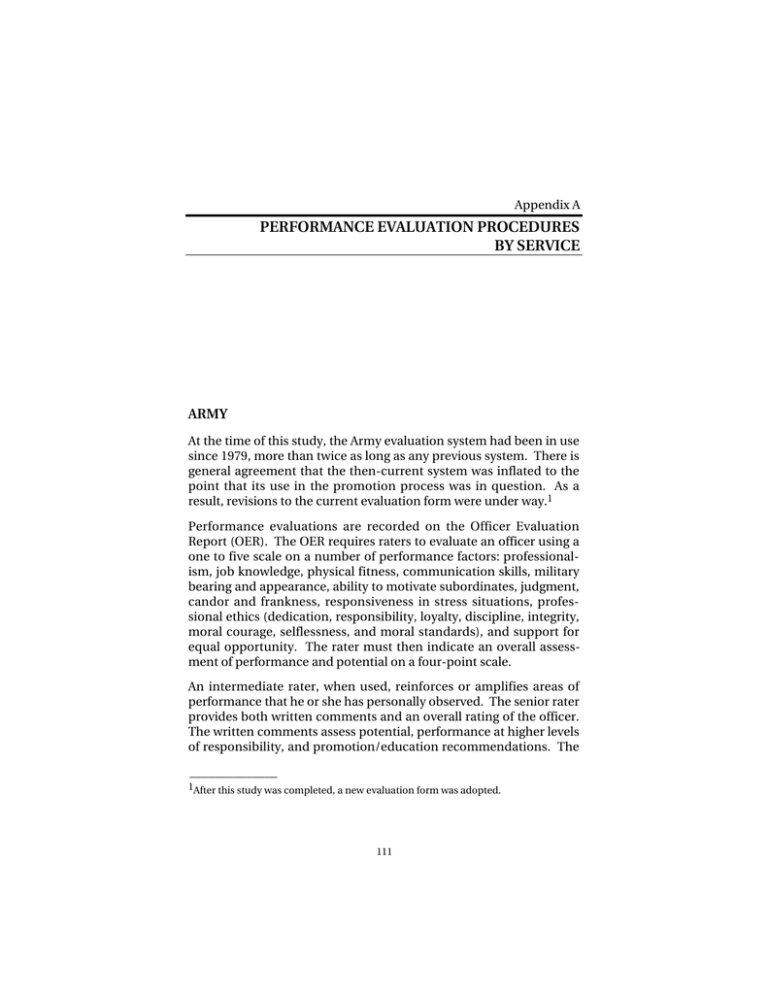PERFORMANCE EVALUATION PROCEDURES BY SERVICE ARMY
advertisement

Appendix A PERFORMANCE EVALUATION PROCEDURES BY SERVICE ARMY At the time of this study, the Army evaluation system had been in use since 1979, more than twice as long as any previous system. There is general agreement that the then-current system was inflated to the point that its use in the promotion process was in question. As a result, revisions to the current evaluation form were under way.1 Performance evaluations are recorded on the Officer Evaluation Report (OER). The OER requires raters to evaluate an officer using a one to five scale on a number of performance factors: professionalism, job knowledge, physical fitness, communication skills, military bearing and appearance, ability to motivate subordinates, judgment, candor and frankness, responsiveness in stress situations, professional ethics (dedication, responsibility, loyalty, discipline, integrity, moral courage, selflessness, and moral standards), and support for equal opportunity. The rater must then indicate an overall assessment of performance and potential on a four-point scale. An intermediate rater, when used, reinforces or amplifies areas of performance that he or she has personally observed. The senior rater provides both written comments and an overall rating of the officer. The written comments assess potential, performance at higher levels of responsibility, and promotion/education recommendations. The ______________ 1After this study was completed, a new evaluation form was adopted. 111 112 Minority and Gender Differences in Officer Career Progression overall rating ranks the officer on a scale of one to nine. Promotion boards are provided with a senior rater’s “profile” of overall rankings to put a rating in appropriate context. The profile presents the distribution of past rating scores that the rater has given. Officers may request a senior rater’s profile, but the profile is not automatically appended to an officer’s OER. Many believe that the system does a poor job of differentiating between performance across officers. Ratings have inflated over time, with most officers now being rated in the top blocks. Further, the written comments also tend to be inflated. Army promotion board members indicated that they find signals for exceptional performance by searching for certain key phrases or words. NAVY Officers receive regular performance evaluations in the form of fitness reports—called FITREPs. There are three types of reports: regular, concurrent, and special. Regular FITREPs are submitted annually or upon the detachment of the officer or his/her reporting senior from an assignment. Concurrent reports are made by a second reporting senior on an officer away at school or on temporary additional duty, for instance. Special reports are made for a specific event or period of time, when the officer’s performance warrants mention, whether positive or negative. The FITREP includes a description of the current duties and responsibilities of the officer, a physical readiness rating, a performance rating, comments describing the officer’s performance, a competitive ranking that measures the officer’s performance in comparison to other officers being evaluated by the reporting senior, and a promotion recommendation. Like all the services, the Navy has periodically revised its performance evaluation system in an attempt to reduce rating inflation as well as to achieve greater objectivity or otherwise enhance the evaluation process. The current FITREP came into use in 1995. The Navy’s new FITREP requires the rater to evaluate an officer on seven performance traits (but no personal traits). Evaluations are made on a five-point scale, ranging from “below standards” to Performance Evaluation Procedures by Service 113 “greatly exceeds standards.” The seven trait grades are arithmetically averaged to provide a single overall score. The old form required the senior rater to provide a ranking of each officer relative to the other officers reviewed by the senior rater (e.g., second of five). In contrast, there is no relative ranking on the new FITREP. Several guidelines have been adopted to direct the written general comments. First, all 5.0 and 1.0 scores must be substantiated with written comments. No relative numerical rankings are permitted, and all comments “must be verifiable.” The form must be typed in a standard format and both highlighted type and handwritten comments are prohibited. As the grades in the old FITREPs became inflated, Navy FITREP writers began to use these methods to emphasize certain written remarks, as a way to indicate exceptional performance. Finally, the form includes a promotion recommendation, which can be marked “not observed,” “significant problems,” “progressing,” “promotable,” “must promote,” and “early promote.” Early promote recommendations are limited to 20 percent of each summary group, and the combined total of early and must promote recommendations is limited to 50 percent of each summary group at the O-3 and O-4 levels and 40 percent at the O-5 and O-6 levels. Promotion recommendations (including early promotion) can be made even for officers not yet eligible for promotion; in other words, an officer not yet eligible for an early, or below-the-zone, promotion may still be rated promote early simply to indicate the reporting senior’s high opinion of the officer. These changes in FITREPs are expected to reduce inflation and lead to greater fairness and ease of interpretation, at least for a while. AIR FORCE Performance is evaluated on the Officer Performance Report (OPR) first by the officer’s immediate supervisor (the rater) and then by the supervisor’s superior (the additional rater), who usually must be at least one grade senior to the officer being rated. The OPR undergoes a quality-control review by a senior officer (the reviewer), who adds comments only if he/she disagrees with the rating. The reviewer is the wing commander or equivalent for lieutenants through majors 114 Minority and Gender Differences in Officer Career Progression and the first general officer in the chain of command for lieutenant colonels and colonels. The OPR includes a description of the unit mission, the job, and the officer’s significant achievements in the job. Six performance factors are evaluated as either “meets standards” or “does not meet standards.” The factors are job knowledge, leadership skills, professional qualities, organizational skills, judgment and decisions, and communication skills. Finally, the rater and the additional rater each provide their assessment of the officer’s performance, and the reviewer indicates whether he or she concurs. Between OPRs, supervisors are required to provide interim feedback to their officers through a handwritten Performance Feedback Worksheet and a face-to-face meeting. Recently, the Air Force required that the supervisors sign the form to indicate that this session occurred. The worksheet includes a rating for each component of the six factors rated in the OPR, using a continuous scale labeled “needs little improvement” at one end and “needs significant improvement” at the other end. There is also space for comments on the ratings. The comments are intended to clarify problems, give specific examples, and provide any other suggestions or assessments. These feedback sessions are intended to be an important component of the evaluation system. The OPR is augmented by the Promotion Recommendation Form (PRF), which is completed 60 days before the officer is considered for promotion in or above the zone; a fraction of those who are below the zone also receive a PRF. The senior rater at the time—the same individual as the reviewer on the OPR—completes this form, which includes the same descriptions and narratives as the OPR and a recommendation to definitely promote, promote, or not promote based on the officer’s cumulative record. 2 The number of officers who can be given a definitely promote recommendation is limited to a fraction less than the fraction who will be promoted. In addition, 10–15 percent of the below-the-zone candidates can be given a definitely promote recommendation. Senior raters forward their PRFs to an evaluation board consisting of senior raters from the numbered Air ______________ 2If the officer has recently been reassigned, the senior rater for the previous assignment completes the PRF. Performance Evaluation Procedures by Service 115 Force, major commands, or headquarters organization level. This evaluation board is responsible for allocating all definitely promote recommendations for small units and the remaining definitely promote recommendations from rounding down the allocations to larger units. The PRF is destroyed after the promotion board for which it is prepared. MARINE CORPS Like the Navy, Marine Corps performance evaluations are also referred to as FITREPs. There are four types of Marine Corps FITREPs: regular, concurrent, academic, and special. Regular reports are given semiannually and also whenever the officer is detached, changes duty, or is promoted, and whenever the officer’s reporting senior changes. Concurrent and special reports serve the same purposes as they do in the Navy. The immediate commanding officer or head of the staff section generally serves as the officer’s evaluator, or reporting senior. The reporting senior grades the officer on performance (regular and additional duties, handling of officers, handling of enlisted personnel, training personnel, tactical handling of troops) and qualities (endurance, personal appearance, military presence, attention to duty, cooperation, initiative, judgment, presence of mind, force, leadership, loyalty, personal relations, economy of management, and growth potential). Grades range from below average to outstanding; reporting seniors may assign a “not observed” score for any category in which the reporting senior feels his or her observation has been limited.3 The FITREP also asks the reporting senior to express his or her willingness “to have this Marine under your command . . . considering the requirements of service in war” (emphasis added) and asks for an indication of commendatory, adverse, or disciplinary action to which the officer was subject. A narrative section instructs the reporting senior to appraise the officer’s professionalism. ______________ 3After this study was completed, the Marine Corps changed its evaluation report. The format, including the categories of performance graded, are now different. 116 Minority and Gender Differences in Officer Career Progression Finally, a reviewing officer, typically the reporting senior’s commanding officer, reviews the FITREP; he or she certifies that he or she either has had no opportunity to observe the officer or concurs/does not concur with the reporting senior’s ranking and evaluation of the officer. A new ranking is given if there is nonconcurrence with the ranking given by the reporting senior. The reviewing officer is asked to state the ranking of the officer relative to all officers of similar rank whom he or she reviews. The reviewing officer may add narrative remarks; such remarks are required if a do not concur is given.



